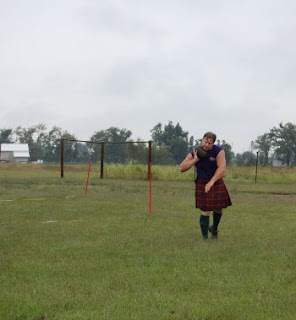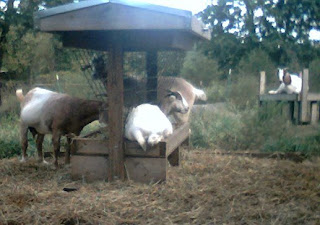
Sarah came to us from another local farm; her previous owners were Hungarian immigrants, an older couple (when I say older means in the general area of 10 years older than I am). They had decided they did not want horns on their goats for safety sake. Sarah at that time, a year old, was too old to be de-horned. We do not believe in de-horning our animals so Sarah fit in perfectly with our herd back then of horned Boer goats.
 Sarah was in kid at the time her previous owners decided to sell her. While they wanted to sell her, they wanted to keep her kids; they also wanted to use her milk to bottle feed her kids. This meant I had to wait 2 long months for her to kid, plus an additional 3 longer months for her kids to be weaned before I could bring her home.
Sarah was in kid at the time her previous owners decided to sell her. While they wanted to sell her, they wanted to keep her kids; they also wanted to use her milk to bottle feed her kids. This meant I had to wait 2 long months for her to kid, plus an additional 3 longer months for her kids to be weaned before I could bring her home.The farm was a very short distance from us, which meant we could go visit Sarah once or twice a month to check on her and allow her to become familiar with us. I enjoyed talking with her previous owners (we’ll call them A and M). A would share her Hungarian recipes and feed Jim samples of all the traditional Hungarian foods she cooked up in her kitchen. A shared her culture recipes for making goat milk yogurt and feta, how to make Hungarian bread (can’t remember the Hungarian name) that I still make during the winter months. A would tell me about her childhood in Hungary, the way things were there, how they came to the US and her family. I think she enjoyed our visits as much as we did. M had a very heavy accent that made it difficult to understand what he was saying let alone talking about. We would listen though have to have A repeat what M was saying.
On one of our visits we were sitting in their living room, I was sitting by a window so I could watch Sarah who was heavy into her 5th month of pregnancy (5 month gestation period for goats). When I noticed that she had something protruding from her tail end. I made everyone jump and run. Sure enough Sarah kidded while we were visiting. She delivered 4 healthy kids, 2 bucks and 2 does. Most goats will kid twins, some have trips, but quads and up are relatively uncommon. Sarah Beth has blessed us each year with quads. Regardless as to the breed of buck we used to sire her kids she continually produced quadruplets. Can you imagine what impact carrying 4 babies each year has on her body?
 We have been debating whether or not to retire Sarah Beth this year. I am not sure I want to. One year we did not breed her. She produced milk for 552 days. That’s about a year and a half, until she was bred again. Granted she dropped in production at different times, though she never failed to produce. I am leaning towards giving her a year off kidding, continuing to milk her, rather than to completely retire her. I am hoping that by giving Sarah Beth a break from the stress of kidding this year she will live longer and stay healthier.
We have been debating whether or not to retire Sarah Beth this year. I am not sure I want to. One year we did not breed her. She produced milk for 552 days. That’s about a year and a half, until she was bred again. Granted she dropped in production at different times, though she never failed to produce. I am leaning towards giving her a year off kidding, continuing to milk her, rather than to completely retire her. I am hoping that by giving Sarah Beth a break from the stress of kidding this year she will live longer and stay healthier.Every morning like clockwork she knows when and what to do. I don’t have to fetch her; she goes to the milk stanchion and waits on me. I open the gate to her pen as I pass on my way to the feed room. She heads to the goat gazebo while I feed, water and hay all the others. She steps up onto the stanchion, puts her head through the key hole to see if by chance there are any morsels remaining from the previous nights feed she missed. She will stand and wait patiently. If I happen to take longer than she feels is necessary she will step off the stand and watch my every move. By the time I am finishing up the morning routine, heading into the house to wash my hands and gather up the milking supplies she is calling my name. Maaaaaaa!
The clink of the handle on the stainless steel bucket as I walk down the back steps is the signal for her to take her position. After she has eaten her morning ration, if I am not finished milking she will turn her head to the side and nuzzle my neck or ear, if she is in a good mood she will lick my cheek. If she is in a bad mood she will bite my hair and occasionally pull it if she is really cranky. She notices if I change scents of shampoo, perfume or laundry detergent. The new scent sets off a Flehmen response (sniffing and curling her upper lip to mark the new scent).
After morning milking I turn her off the milk stand to spend the day as she pleases until evening milking. She has free access to go anywhere on the farm she wishes (other than into the other goat pens). She has her own hay. Bales of fresh, rich, green Alfalfa to munch on in addition to the grass, weeds and browse around the farm. I set a square bale by the barn door, which she nibbles on, when she feels inclined to do so. Heaven forbid she doesn’t get her bale of Alfalfa, she will come get me. Up the ramp to the front porch and knock on the door. Her knock - horns being smacked against the glass of the front door. I made the mistake of leaving her with only a grass mix bale one day and that did not set well. She kept coming up whacking at the front door until I went out to find the error of my ways. Seriously, after I put the Alfalfa out she stopped whacking the front door.
Sarah Beth produces some really cute kids. The photo below is one of her December 07 kids. We called him Brother, a little white Saanen buckling. He and his brother Mickey went to live as pet wethers at a farm about 4 miles from us. Looks just like his mama :)
Isn't this adorable? I found this on line and couldn't resist sharing. :)
























 I'd say it is a good 3 foot deep. It's not just the rainfall, it's water that collects in the pond, alot of run off from the hills. Those wooden things sticking up are the remains of a dock. Dry rotted legs of a wooden dock built years ago, cut down in fear of the goats falling and killing themselves (yes had one do it a couple years back). I made the better half go out and cut it down with a chain saw after the accident. Someday this will be cleaned up so I don't have to look at it. It's on his to do list.
I'd say it is a good 3 foot deep. It's not just the rainfall, it's water that collects in the pond, alot of run off from the hills. Those wooden things sticking up are the remains of a dock. Dry rotted legs of a wooden dock built years ago, cut down in fear of the goats falling and killing themselves (yes had one do it a couple years back). I made the better half go out and cut it down with a chain saw after the accident. Someday this will be cleaned up so I don't have to look at it. It's on his to do list.






 Light weight goats. They have had enough and decide to return to house without me.
Light weight goats. They have had enough and decide to return to house without me.












